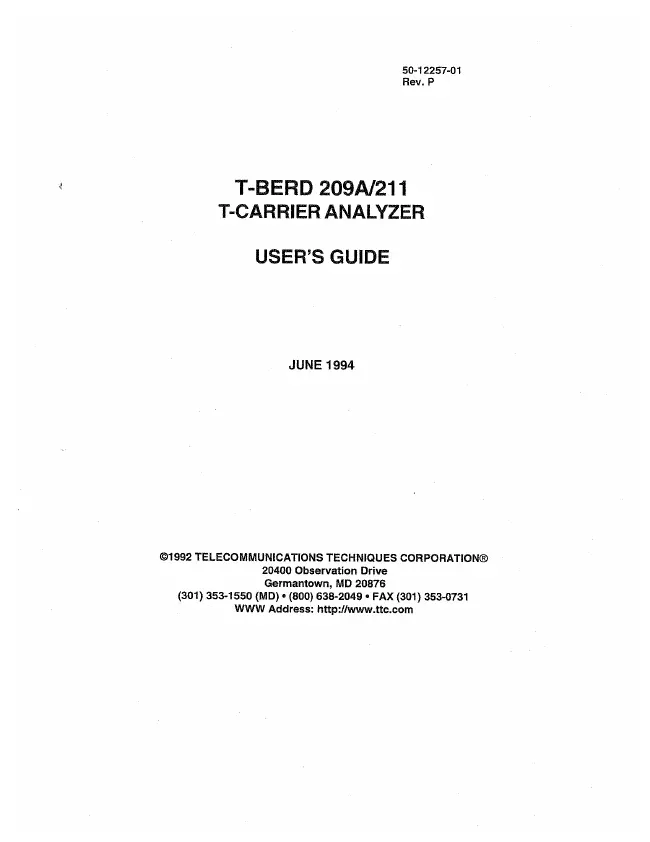Telecommunications Techniques Corporation - T-Berd 211 - Analyzer
Manufacturer:
No picture available!
Maybe you can
upload a pic
for the
Telecommunications Techniques Corporation T-Berd 211 ?
If you have any other manuals for the
Telecommunications Techniques Corporation T-Berd 211
you can
upload the files here.
.
Equipment:
T-Berd 211
Date:
1994
Category:
Group:
Sub Group:
Information
The T-BERD 211 is a portable test instrument that
comprehensively analyzes T1 and TIC transmission systems.
Used in the central office and in the field, the T-BERD 211
is used during circuit installation, acceptance testing, and
fault isolation. In the central office, the T-BERD 211 can
either generate and receive test patterns for out-of-service
testing or monitor T1 and TIC circuits without service
interruption. In the field, the instrument detects and
isolates problems related to customer-owned equipment (e.g.,
Customer Service Unit (CSU)) and detects problems
originating from the T1 span line; no CSU is required for
span line testing.
The T-BERD 211 offers these key features and characteristics:
(1) D4, ESF, and SLC*-96 framing patterns offer
compatibility with a variety of framing formats. An unframed
mode is also available for applications where framing is not
required.
(2) Summary Test Results category displays key non-zero and
“out- of-spec” results, eliminating the search through long
lists of test results.
(3) Automatic Configuration Mode lets the T-BERD 211
configure to the proper line rate (T1 or TIC), framing,
coding, and pattern. No set-up is required when monitoring
live circuits.
(4) Simultaneous Logic Error, Bipolar Violation, and Frame
Error Analysis with associated error rate, errored seconds,
and percent error-free seconds calculations.
(5) Signal Analysis with simplex current, signal level,
timing slip, and recovered clock frequency measurements.
(6) Jitter Analysis with jitter wideband and highband
measurements, and a Spectral Analysis option that displays
the relative amount of jitter as a percentage of a
specification mask. The T-BERD 211 also features a jitter
alarm LED that immediately illuminates when jitter is
present on the received T1 signal.
(7) Pulse Shape Analysis allows you to measure the height,
width, rise time, fall time, overshoot and undershoot of a
T1 pulse. Pulse shapes can also be measured for conformance
to AT&T Compatibility Bulletin 119 or ANSI T 1.403 Network
Interface specifications.
(8) Slips and Wander measurements identify wander
impairments or the potential for frame slips.
(9) Logic, BPV, and Frame Error Insertion enables the T-BERD
211 to simulate errors as they actually occur. Errors may be
inserted singly, in a burst, or at variable rates.
(10) RS-232 Printer/Remote Control
Interface allows you to
print graphic displays (e.g., pulse shapes) and error
analysis results, and to remotely control the T-BERD 211.
(11) Results History Buffer stores up to 6 sets of your most
recent test results which can be viewed from the front panel
(12) All Zeros test pattern allows the T-BERD 211 to test
B8ZS and ZBTSI circuits where the zeros are encoded to meet
specification requirements limiting excess zeros. When
transmitting all zeros, the T-BERD 211 determines if the
circuit is capable of transporting B8ZS encoded data.
(13) Automated bridge tap detection test allows the T-BERD
211 to more thoroughly evaluate a T1 span for bridge taps.
The test automatically generates 21 test patterns which are
monitored for errors. The T-BERD 211 displays the cumulative
test results and which patterns experienced one or more bit
errors on the front panel. It also provides a RESULTS
printout which indicates the number of bit errors, errored
seconds, and pattern synchronization seconds for each pattern.
(14) Automated multipattern test simplifies testing by
generating five standard T1 test patterns in 15 minutes,
eliminating the need to perform individual tests with each
pattern. The T-BERD 211 displays the cumulative test results
for the test and which patterns experienced one or more bit
errors on the front panel. It also provides a RESULTS
printout which indicates the bit error, errored second, and
pattern synchronization second results for each pattern.
(15) Clear history and printer buffers function allows the
T-BERD 211 to clear the history and printer buffers of
stored results.
(16) Printer squelch function automatically suspends the
T-BERD 211 printouts when excessive alarm, error, and
severely errored second conditions occur during a test.
(17) Optional programmable long user pattern allows a 1- to
2000- character hexadecimal pattern to be transmitted to
determine circuit sensitivity to the pattern. The option
also provides a minimum/ maximum density stress pattern
selectable from the front panel PATTERN switch (MIN/MAX test
pattern).
(18) Optional T1 ZBTSI encoded Extended Superframe Mode
allows the T-BERD 211 to transmit and receive ZBTSI (Zero
Byte Time Slot. Interchange) encoded ESF framed T1 data. The
option also allows framing errors to be inserted in the ESFz
F-bits or Z-bits.
User manual
Manual type:
User manual
Pages:
348
Size:
1.2 MB
Language:
english
Revision:
P
Manual-ID:
50-10995-02
Date:
June 1994
Quality:
Scanned document, all readable.
Upload date:
Jan. 10, 2017
MD5:
b7a53632-5694-5dde-8cf9-27413de47ddf
Downloads:
733
User manual
Manual type:
User manual
Pages:
122
Size:
2.9 MB
Language:
english
Revision:
P
Manual-ID:
50-12257-01
Date:
June 1994
Quality:
Scanned document, all readable.
Upload date:
Jan. 10, 2017
MD5:
a90a7503-af91-02ba-b3a1-714c7dd26f1f
Downloads:
965
User manual
Manual type:
User manual
Pages:
276
Size:
6.6 MB
Language:
english
Revision:
A
Manual-ID:
ML10995-02
Date:
July 1990
Quality:
Scanned document, all readable.
Upload date:
Jan. 15, 2017
MD5:
d5ca4ca9-2545-f3fd-6daf-3ad577a81349
Downloads:
591


